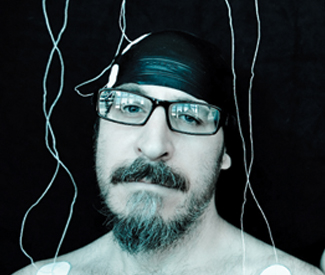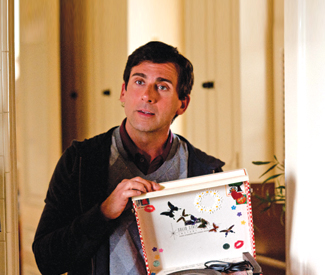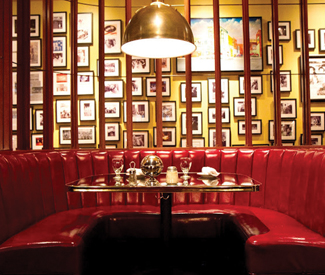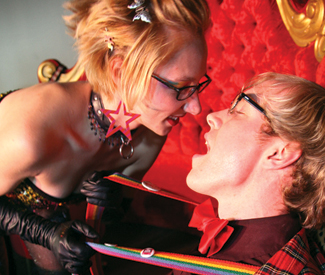ONGOING
Faetopia Tower Records building, 2286 Market, SF. www.faetopia.com. Through Fri/22, noon-midnight, (event times vary), $10 suggested donation. What’s a radical queer to do in the season of commercialized sexuality? Seize an empty records store and fill with blithe faggotry. The crew behind Faetopia is organizing nights of queer cinema, hip-hop and ecology classes, drag musicals, skillshares, and much more — drop in.
Frameline Film Festival Various times and venues, SF. Through Sun/24. www.frameline.org. The 36th year of this international gay and lesbian film fest has taken over SF — from a documentary on a female Olympian weightlifter to sweet tales of love, to goofy nights of short flicks.
National Queer Arts Festival Various times and venues, SF. www.queerculturalcenter.org. The fest has been raging since the start of the month, but this week you can catch Marga Gomez at the LGBT Center (Fri/22), darkly humored dance pieces at The Garage (Sat/23), and Ali Liebegott’s “Faggot Dinosaur” art exhibit at Alley Cat Books.
“Searching for Queertopia” Galeria de la Raza 2857 24th St., SF. www.galeriadelaraza.org. Through June 30. 7:30pm, free. An exhibition documenting Las Intrépidas, a traditional celebration of muxe (queer) culture in the Oaxacan town of Juchitán de Zaragoza.
WEDNESDAY 20
The Guardian’s 8th annual Pullin’ Pork for Pride Pilsner Inn, 225 Church, SF. www.sfbg.com. 5:30-9pm, free. Squee! Our annual meat treat (free pulled pork sandos for all!) will be soundtracked by Hard French heartthrobs, DJs Brown Amy and Carnita.
Gay Pride Comedy Show Deco Lounge, 510 Larkin, SF. (415) 346-2025, www.decosf.com. 7pm, $20. Camp out at this lineup of stand-up queers, compiled by hometown comedian Charlie Ballard in order to challenge the common perception of what a gay person is.
Bi-BQ bisexual pride potluck and promenade Dolores Park Café, 501 Dolores, SF. (707) 799-4343, www.sfpride.org. 5pm, free. The pre-party for Frameline Film Festival’s showing of Bi-Candy features a potluck barbeque, Dolores Cafe performances, and a promenade en masse to Victoria Theatre.
Booty Call QBar, 456 Castro, SF. www.bootycallwednesdays.com. 9pm-2am, $3. The thing about Booty Call — besides its quickly-shirtless bevy of Castro babes — would be its extravagant photobooth, designed each week by a different, deserving SF creative type. Get trashed, dance crazy, but stay pretty for the camera (and hostess Juanita More.)
Stay Gold Public Works, 161 Erie, SF. www.publicsf.com. 10pm-3am; $3 before 11pm, $5 after. Suggested apparel for the Pride edition of the monthly queer hip-hop banger: vinyl flower print bodysuit, winged sneakers, ass.
THURSDAY 21
Dude magazine launch party Eros, 2051 Market, SF. www.erossf.com. 7-10pm, free. Australian transmasculinity zine is planting a flag in our soil, and celebrating with this reception at all-male sex club Eros.
“Fabulous” Creativity Explored, 3245 16th St., SF. www.creativityexplored.org. Through Aug. 1. Opening reception: 7pm-9pm, free. Artist Sara O’Sullivan curates this collection of gender-bending and queer culture at CE’s gallery for developmentally-disabled creative people. Inspired by O’Sullivans love of drag queens, the show features a life-size hot pink cardboard drum set.
OccuPride planning meeting Faetopia, 2286 Market, SF. www.faetopia.com. Perhaps you’re one of those radical queers looking for some outlet for your general angst regarding capitalism and the over-commercialization of even our most human desires. Hie thee to this get-together of like-minded souls who will be planning an action to take Pride back to its alternative roots.
Pride Nightlife California Academy of Sciences, 55 Music Concourse, Golden Gate Park, SF. www.calacademy.org. 6-10pm, $12. Sexologist Carol Queen, drag fauna Juanita More and Heklina, darling queer DJs, and other exotic fauna join Claude the albino alligator at the Academy’s weekly party night. Star”gay”ze in the planetarium and learn about the same-sex predilections of your fave constellations.
Stone Pony solstice anniversary Stone Pony, 3552 20th St., SF. 6-10pm, free. If you haven’t assembled your outfits for the weekend but can’t stomach the thought of hitting the thrift town racks, you’ve come to the right place — this mystical vintage boutique is celebrating its Pride season one-year anniversary with champagne, “epic floral arrangements,” music, and yes — style style style for sale sale sale.
Wrestle Mania Pride Kick-off Party Lexington Club, 3464 19th St., SF. www.lexingtonclub.com. 9pm, free. Do babes with biceps get you bent? Cruise to the Lex for its lezzie arm wrestling party — where you won’t need to strong arm anyone to get them moving to DJs Ms. Jackson and China G.
FRIDAY 22
Bearracuda Public Works, 161 Erie, SF. www.publicsf.com. 9pm-3am, $10–$15. Fluff your fur for this bear bash — Doc Sleep, Ted Eiel, dabecy from Electronic Music Bears, and Robert Jeffrey of Dial Up give you something to step to.
Bibi five-year anniversary Som Bar, 2925 16th St., SF. www.som-bar.com. . 9pm-2am, $15 advance tickets. This is the only Pride party featuring non-metaphoric sword acrobatics. The queer Middle Eastern-North African community will converge for the fifth anniversary of its favorite, undulating dance party. Belly dance and aforementioned sword play figures alongside DJs Emancipation and Nader.
Bustin’ Out! Official Trans March After-Party El Rio, 3158 Mission, SF. www.elriosf.com. 8pm, $5–$50. DJs Ome, Jillio, and Bobby of Tortillas Picantes will spin at the be-patioed, community-oriented Mission bar. The get-down is a benefit for TGI Justice, a network of transpeople in and out of jail who are set on defeating the unjust prison industry.
Horse Meat Disco Mezzanine, 444 Jessie, SF. www.mezzaninesf.com. 9pm, $17. A huge mixed party (also including awesome local sunny electronic duo Poolside, the jubilant sounds of Crystal Ark, and the Honey Soundsystem DJs) will feature the beloved Horse Meat boys from London, who did much to stoke the last decade’s obsession with rare disco and classic house treats.
Marga and the Babes queer comedy LGBT Center, 1800 Market, SF. www.queerculturalcenter.org. Marga Gomez does a mean Desi Arnaz impersonation (among her other talents). Join the Bay favorite yuckster and adorable queer comics Natasha Muse and Justin Lucas tonight.
MR. Monarch, 101 Sixth St., SF. www.clubmonarch.net. 9pm-4am, $15. It’s the last twirl for this fabulous annual dance-around hoo-haw: Slammin’ (real) house DJs David Harness, Ellen Ferrato, and Rolo spin some amazing tunes to help you find a fine fellow whisker whisperer or just a quick ride. Borrow a mustache; this’ll be a good one.
Neon Vinyl The Ambassador, 673 Geary, SF. www.ambassador415.com. 10pm, free. DJs Enso, Kool Karlo, and Ilya bring future-retro Pride beats and decades of dance tracks poured through a house filter.
Old French Hole The Knockout, 3223 Mission, SF. www.theknockoutsf.com. 9pm-2am, $5. Assemble your favorite old-timey dance partiers from up and down the West Coast (the Hard French kiddos, DJ Primo from the Knockout’s aces Oldies Night, DJ Beyondadoubt from Portland’s Hole in My Soul), pump them full of Pride-ful pleasure, and call it a really stupid amalgamation of their party names. Twist, and shake.
Radical Queer Vegan Anti-Social Modern Times Bookstore, 2919 24th St., SF. www.gayshamesf.org. 5:30pm, free. But what of the sober queer, or the queer that cares more for sustainable food systems than Absolut cocktail specials? This Pride-time edition of the monthly Gay Shame potluck-roundtable might be flush with fresh-faced, vegan out-of-towners, so start soaking those cashews now.
San Francisco Lesbian/Gay Freedom Band Pride concert SF Conservatory of Music, 50 Oak, SF. www.sfcm.edu. 7pm and 9pm, $15–$30. Jack Curtis Dobowsky’s “Harvey Milk: A Cantata” will be featured at this musical celebration with SF community choral groups. Come early — 6:15pm — to hear Dobowsky talk about the creation of his piece, which features unpublished texts by Milk himself.
Steam Powerhouse, 1347 Folsom, SF. www.powerhouse-sf.com. 10pm-2am, $5. As far as partying in a towel goes, this party is the ultimate. Down cheap tequila in one of SoMa’s evolving sex clubs, cruise the man meat, get a buck-a-minute massage, and ditch the terrycloth for a spin in the famed Powershower.
The Super Queer Open Mic Show Center for Sex and Culture, 1349 Mission, SF. www.sexandculture.org. 8pm, $12–$20. Eight years of queers grabbing the microphone are celebrated at this year’s Pride edition of the reading series. Trans artist Amy Dentata and genderqueer humorist Dana Morrigan star as featured guests.
Trans March Dolores Park, Guerrero and 20th St., SF. www.transmarch.org. 3:30-6:30pm park gathering; 6:30pm march to UN Plaza, free. Could this be our favorite parade of Pride? It’s hard to pick sides, but this all-ages gathering of the transgendered community makes a good case for itself. A First Peoples’ welcoming and blessing with Ohlones and two-spirit folks is one highlight of this feel-good manifestation.
Unofficial: the third annual Original Plumbing trans pride dance party Elbo Room, 647 Valencia, SF. www.elbo.com 10am-2pm; $7 before 11pm, $10 after. The all-around cutest transguy zine out there is throwing down the welcome mat for your post-march dancefest. Get snapped by photog Amos Mac and get it done on the dancefloor to DJ Rapidfire of Stay Gold and NYC’s DJ Average Jo. Kelly Lovemonster go-gos!
We’re Here, We’re Queer, We’re Some Thing The Stud, 399 Ninth St., SF. www.thestudsf.com. 10pm-late, $10. In honor of the swish season, SF’s weekly alt-drag dance party fantasy is staying up late. Cast of characters includes Glamamore, Ambrosia Salad, and NYC’s House of Stank. Host Vivvyanne Forevermore promises surprises, or rather “big, gay surprises.”
SATURDAY 23
A Coupla Old Crackpot Crones The Garage, 715 Bryant, SF. www.crackpotcrones.com. 8pm, $15. One-time Green Party mayoral candidate and playwright Terry Baum and comedian Carolyn Myers pull together a variety show to benefit the Pat Bond memorial Old Dyke Award. Mom coming out, Baum’s surprise 2011 election appearance, and Eleanor Roosevelt’s lady love all figure in sketches.
Bondage A Go-Go Cat Club, 1190 Folsom, SF. www.sfcatclub.com. 9:30-2:30am, $10-20. Wear your pink and black to this lustful benefit for struggling, worker-owned stripclub The Lusty Lady. Dancers from the Lusty will host a spank-a-thon, and offer lap dances in exchange for contributions towards the future of our favorite sex-positive titty bar.
Country Pride Sundance Pre-Party Sundance Saloon, 550 Barneveld, SF. 8pm-midnight, $10. There’s always quite a lineup of hot hoofers at this regular country line-dance hootenanny — but the pre-Pride bonanza will be full of new faces and spiffy boots and saddles.
Dark Room The Hot Spot, 1414 Market, SF. Dark electro, witchy goth, and cutting-edge spook-house darken the door of this Civic Center dive as the drag-and-laser-studded monthly freakfest raises money for Lyon-Martin Health Services. (100 percent of door proceeds will benefit reproductive health in SF!)
Dyke March Dolores Park, 20th St. and Guerrero, SF. www.thedykemarch.org. DJs noon-5pm, march at 6pm, free. Sit pretty in Dolo, swigging a homemade watermelon margarita made by your industrious neighbor at this centerpiece to ladylove Pride season. When you hear the revving of Dykes on Bikes, you’ll know it’s time to relocate to the parade route.
Go Bang! Go Pride! Deco Lounge, 510 Larkin, SF. www.decosf.com 9pm-3am, free before 10pm, $5 after. You better! The city’s loveliest underground disco tribute gives the Studio 54 treatmeant (gritty Tenderloin version) to Pride, with DJs Redux, Marcus Jerard, Steve Fabus (happy birthday!) and Sergio.
Good Vibrations Pink Pleasure Party Good Vibrations, 603 Valencia, SF. www.goodvibes.com. 8pm, free. This is not the weekend for a poorly-stocked bedside drawer. Good Vibes pulls in DJs Becky Knox and Dalle for its yearly Dyke March hang-out. Snag you a strap-on from SF’s most famous sex shop and get festivating.
It Gets Indie teen benefit concert Great American Music Hall, O’Farrell, SF. Facebook: it gets indie. 7:30pm, $25. Princeton and Local Hero top the bill at the show to benefit the “It Gets Better” campaign.
Lexington Club Dyke March after-party Lexington Club, 3464 19th St., SF. www.lexingtonclub.com. 9pm-2am, free. DJ Ms. Pop presides over the heaving, hot masses at this no-cover, low-attitude dance banger. Grind with your “love” in the post-March endorphin rush.
No Way Back and Honey Soundsystem Soundsystem Monarch, 101Sixth St., SF. www.clubmonarch.net. 7pm-2am, $5. No Way, Honey! Two of our favorite intelligent house and techno crews join forces for two levels of stratospheric bliss. Hot hot hot dancing and very smart dancers.
Pink Triangle installation and commemoration Twin Peaks Vista Overlook, SF. www.thepinktriangle.com. 7:30am installation,10:30am ceremony, free. Volunteers needed for this awesome tradition: putting that huge-ass pink triangle up on Twin Peaks. Get some elevation and lend a hand.
Pride Festival Civic Center, SF. www.sfpride.com. Noon-6pm; Also Sun/24 $5 donation. For a glimpse at the commercial pull of the LGBT community, check out the vendor stalls at this mega-mass. Gay doggie sweaters galore. But it’s not all commercial — BSDM and radical faerie areas give wandering attendees the chance to learn more about alternative sexualities from those who practice them in real life.
(p)RIDE Party Public Works, 161 Erie, SF. www.publicsf.com. 9pm-3am, $8–$10. A can’t-miss combination for those looking to pop ass all night: the Stay Gold DJs are teaming up with their friends from Ships in the Night, Party Hole, and Queer Qumbia. Hip-hop served all night long with a side of vogue.
SUNDAY 24
Continental breakfast at the Lex Lexington Club, 3464 19th St., SF. www.lexingtonclub.com. 3pm, free. Will there be food at this continental breakfast? Well… the press release didn’t specify but know that the Mission’s fave dyke dive will be hawking Pride-special mimosas and bloodies. DJ Katie Duck spins your hunger pangs away with sunny Sunday soul, blues, and rock 45s.
Hard French Hearts Los Homos SomArts Cultural Center, 4-11pm, $25–$60. hardfrenchpride2012.eventbrite.com. Eclectic electric! This year, the cruisey queer golden children pull out all the stops. Oakland soul legend (and Etta James’ homegirl) Sugar Pie DeSanto headlines, with mustache-lipstick indie electricians SSION and PDX bounce soundsmith Beyondadoubt in supporting roles. Wave (your hips) goodbye to Pride with resident HF DJs Brown Amy and Carnita and their patented soul 45s sunshine.
Honey Soundsystem Holy Cow, 1535 Folsom, SF. www.honeysoundsystem.com. 6pm-3am, $5. The queer techno crew’s weekly Sunday parties are absolute musts for sophisticated queers who love a transcendent musical and artistic mix of past-present-future sounds and sights. And then everyone makes out. (Special extended hours, y’all.)
Juanita More’s Pride Party Chambers, 601 Eddy, SF. 12:30-6pm; Jones, 620 Jones, SF. 3pm-midnight. www.juanitamore.com. $25 advance tickets. After eight years in the game, Juanita’s bash, the place to be for discerning queers, has outgrown the patio of the Phoenix Hotel — the action’s spread to encompass two venues, with shuttle buses ferrying drag groupies in between the two. Benefiting the LGBT Community Center, which turned 10 this year, the party will feature one of Pride’s annual highlights, a performance by the young Cougar Cadets drumline.
Pride Parade Begins at Market and Beale, ends at Market and 8th St., SF. www.sfpride.org. 10:30am, free. This is where you will try to catch Sarah Silverman (and try not to weep when the PFLAG contingent passes) before the hangover/desire for more alcohol overwhelms. Stay strong, soldier!
Queerly Beloved El Rio, 3158 Mission, SF. www.elriosf.com. 3-8pm, $7–$10. Glittorises will tremble for local alt-queer pornographer Courtney Trouble in a rare live burlesque performance — and she’s bringing a queer smut cavalcade with her to move the earth. FTM dreamboat James Darling burlesque babe Dorian Faust, and the crew from live sex sensation Cum & Glitter will perform sensual wonders; DJs and Lady Tragik provide dance party, and a kinky kissing booth will welcome those whose lips aren’t otherwise entertained.
TUESDAY 24
This is What I Want Various times and venues. www.whatiwantfestival.com. Through June 30. How does our desire shift with the economy? Links between the heart, loins, and stock market are explored at this performance art festival, which has an important symposium component in which attendees will lend their voice to to those on stage.












